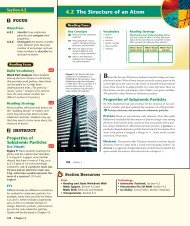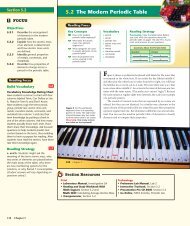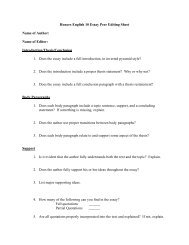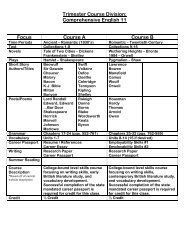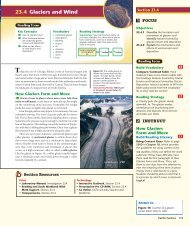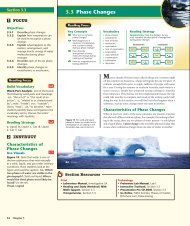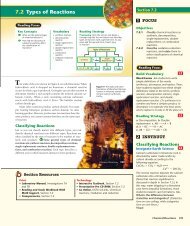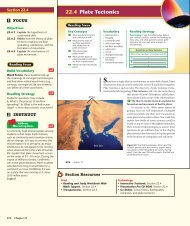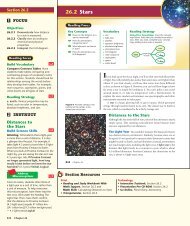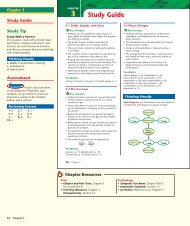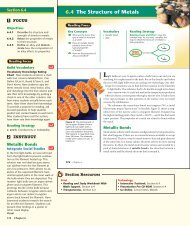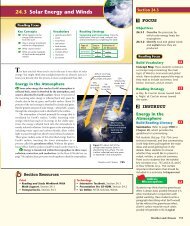23.6 Earth's History
23.6 Earth's History
23.6 Earth's History
You also want an ePaper? Increase the reach of your titles
YUMPU automatically turns print PDFs into web optimized ePapers that Google loves.
Earth’s history is divided into several large units, called eras. Each<br />
era is one major stage in Earth’s history. An era is further divided into<br />
smaller units called periods. Eras and periods help scientists locate<br />
changes and events in Earth’s history.<br />
Some boundaries between eras mark a time when many different<br />
kinds of organisms became extinct within a relatively short time. Such<br />
an event is called a mass extinction. Scientists have developed several<br />
theories to explain what caused mass extinctions. These theories<br />
include asteroid impacts, volcanic activity, disease, and climate change.<br />
For nearly 4 billion years, changes in Earth’s surface, atmosphere, and<br />
oceans have effected the development of living things. Living things, in<br />
turn, have changed Earth. The major divisions of Earth’s history<br />
are Precambrian time and the Paleozoic, Mesozoic, and Cenozoic Eras.<br />
Precambrian Time: 4.6 Billion–542 Million Years Ago<br />
The earliest portion of Earth’s history, known as Precambrian time,<br />
includes the formation of Earth and the early development of life. At<br />
first, Earth’s surface was largely molten and was continually bombarded<br />
by meteorites. By 4 billion years ago, the forces that cause plate<br />
movement were already at work. Soon after, one-celled organisms<br />
appeared in the oceans. Tiny photosynthetic organisms took up carbon<br />
dioxide from the atmosphere and released oxygen. Later in the<br />
Precambrian, simple soft-bodied animals developed. Since soft bodies<br />
don’t usually form fossils, there are few fossils from Precambrian time.<br />
Paleozoic Era: 542–251 Million Years Ago Early in the<br />
Cambrian period (the first period of the Paleozoic Era), a variety of animals<br />
developed in the oceans. Scientists think that some of these animals<br />
were related to the clams and worms found in the oceans today. Many<br />
other types of early animals, such as those shown in Figure 35, became<br />
extinct. But more than 450 million years ago, fishes evolved in the oceans.<br />
Plants and animals, including early reptiles, began to live on land. Dense<br />
forests of mosses and cone-bearing plants covered much of the land.<br />
At times during the Paleozoic, parts of many continents were<br />
flooded by seas. Thick layers of sediment deposited in these seas<br />
formed much of the sedimentary rock found on the continents today.<br />
During the last period of the Paleozoic Era, the Permian period, the<br />
supercontinent Pangaea formed.<br />
When did fishes first appear?<br />
For: Articles on Earth’s history<br />
Visit: PHSchool.com<br />
Web Code: cce-3236<br />
Figure 35 During the early<br />
Paleozoic Era, life began to evolve<br />
into many different forms. This<br />
scene shows how life might have<br />
looked on the sea floor during the<br />
Cambrian Period.<br />
299 251 200 145 65 23 0<br />
PERMIAN TRIASSIC JURASSIC<br />
Facts and Figures<br />
MESOZOIC<br />
Early <strong>History</strong> Earth, like the rest of the solar<br />
system, formed about 4.6 billion years ago out<br />
of a cloud of dust and gas. After 50 million<br />
years, Earth was close to its current size and<br />
was so hot it was possibly entirely molten.<br />
The following 4.5 billion years have been a<br />
period of continuous cooling.<br />
The molten state of early Earth allowed<br />
the planet to separate into different layers.<br />
The surface was not stable, so the early crust<br />
would sink back into the molten interior.<br />
CRETACEOUS PALEOGENE NEO-<br />
GENE<br />
CENOZOIC<br />
PERIOD<br />
ERA<br />
Earth’s Surface 735<br />
Eventually, Earth cooled enough to resemble<br />
the planet you see today. Water vapor in the<br />
atmosphere condensed to form rain and<br />
create the oceans. The mantle solidified, and<br />
the continental crust began to form at the<br />
surface. The core cooled enough so that<br />
the inner core began to solidify. The exact<br />
timing of these events is uncertain. However,<br />
radioactive dating shows that Earth had<br />
developed a system of plate tectonics<br />
approximately 4 billion years ago.<br />
Integrate Chemistry<br />
Half of the remaining potassium-40 in a<br />
rock will decay to Ar40 L2<br />
every 1.3 billion<br />
years. This means that if a rock is 3.9<br />
billion years old, or three half-lives of<br />
1<br />
potassium-40, the rock will contain 8<br />
of its original potassium-40. For recent<br />
geologic events like volcanic eruptions,<br />
the isotope carbon-14 is often used to<br />
measure the age. Carbon-14 has a halflife<br />
of 5730 years, so it is useful for<br />
dating geologic and anthropological<br />
objects that are less than a hundred<br />
thousand years old. Ask, If threequarters<br />
of the carbon-14 in a piece<br />
of pottery had decayed into daughter<br />
isotopes, approximately how old is<br />
the pottery? (11,460 years) Why<br />
wouldn’t carbon-14 be useful for<br />
dating rocks? (The ages of rocks are<br />
typically in the tens or hundreds of<br />
millions of years. With a half-life of only<br />
5730 years, only a miniscule amount<br />
of carbon-14 would be left in a rock<br />
that old.)<br />
Logical<br />
Build Reading Literacy<br />
L1<br />
Identify Main Idea/Details Refer<br />
to page 702D in this chapter, which<br />
provides the guidelines for identifying<br />
main idea and details.<br />
Using four index cards, have students<br />
write the name of each geologic era on<br />
a card. While reading A Brief <strong>History</strong> of<br />
Earth, have students record the main<br />
details of each era on the appropriate<br />
index card. Encourage students to use<br />
bullet points, rather than copying whole<br />
sentences. Have the students share their<br />
cards in small groups and fill in any<br />
missing main details, then align them in<br />
geologic time.<br />
Verbal, Group<br />
Science News provides students<br />
with current information on<br />
Earth’s history.<br />
Answer to . . .<br />
Figure 34 The Triassic, Jurassic, and<br />
Cretaceous periods<br />
Fishes first appeared in<br />
the early Paleozoic Era,<br />
more than 450 million years ago.<br />
Earth’s Surface 735



